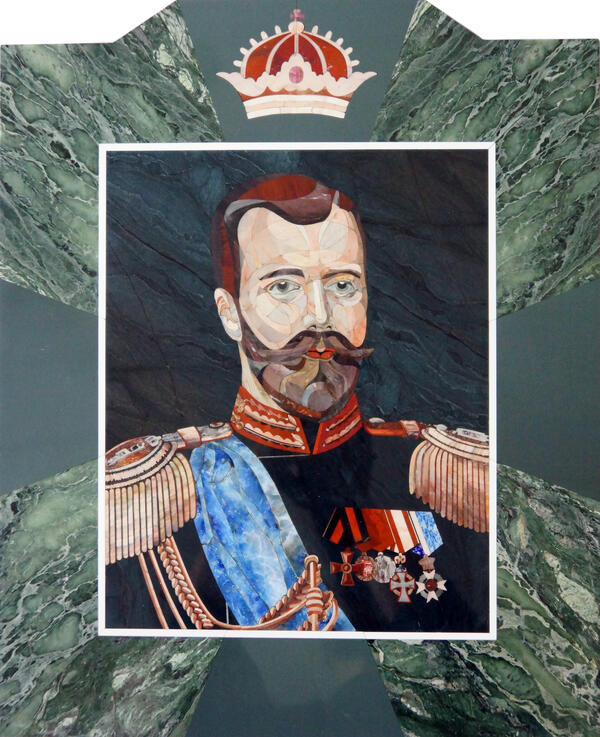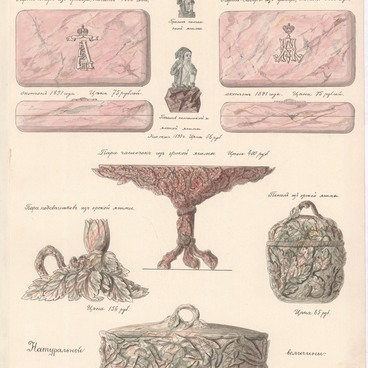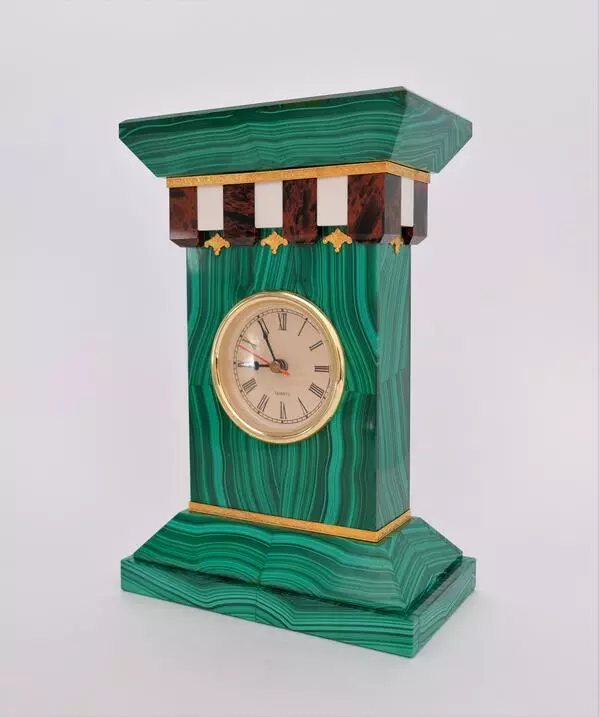The stone portrait of Nicholas II was created in the Florentine mosaic technique at the Sverdlovsk factory “Russkiye Samotsvety” (Russian Gemstones). It was designed by Natalia Bebko and L. N. Malkova. Several masters of stone mosaic worked on it: I. S. Pogodin, M. A. Semenovskikh, V. V. Klevakin, V. P. Chernavskikh, V. N. Torkhov.
Two such portraits were created at the “Russkiye Samotsvety” factory. One of them was sold to a private collector, the second was transferred to the Museum of Stone-Cutting and Jewelry Art History.
Florentine mosaic is a technique in which parts made of multi-colored stones are so tightly pierced together that the seams between them are almost invisible. Decorative wall panels, chessboards, tabletops and casket lids are made and decorated in this technique.
This type of mosaic appeared in Italy around the 16th century. Prominent artist and sculptor Michelangelo called works in this technique “eternal paintings”. The works of Florentine masters were first brought to Russia in the middle of the 18th century, during the reign of Empress Elizabeth of Russia. Russian stonecutters quickly mastered the technology and by the beginning of the 19th century began to produce their own items.
The tradition of creating stone portraits of Imperial House members originated at the Yekaterinburg Lapidary Factory in the 19th century. On May 26, 1837, Tsarevich Alexander Nikolayevich (future Alexander II) visited it. Precious gifts were presented to him. One of tsarevich’s teachers, Aide-de-Camp Semyon Yuryevich, wrote that there were “well-made stone portraits of the sovereign and empress which were very believable” among the gifts. The portraits were cameos carved from chalcedony. Students from a stone-carving workshop, which was part of the factory, made them.
For the 16th All-Russia Industrial and Art Exhibition, which was held in Nizhny Novgorod in 1896, Yekaterinburg craftsmen made an image of a golden eagle. In its paw, it held a medallion with a portrait of Nicholas II, lined with jasper of various types. After the exhibition, this product was presented to the monarch’s wife, Empress Alexandra Feodorovna.
Two such portraits were created at the “Russkiye Samotsvety” factory. One of them was sold to a private collector, the second was transferred to the Museum of Stone-Cutting and Jewelry Art History.
Florentine mosaic is a technique in which parts made of multi-colored stones are so tightly pierced together that the seams between them are almost invisible. Decorative wall panels, chessboards, tabletops and casket lids are made and decorated in this technique.
This type of mosaic appeared in Italy around the 16th century. Prominent artist and sculptor Michelangelo called works in this technique “eternal paintings”. The works of Florentine masters were first brought to Russia in the middle of the 18th century, during the reign of Empress Elizabeth of Russia. Russian stonecutters quickly mastered the technology and by the beginning of the 19th century began to produce their own items.
The tradition of creating stone portraits of Imperial House members originated at the Yekaterinburg Lapidary Factory in the 19th century. On May 26, 1837, Tsarevich Alexander Nikolayevich (future Alexander II) visited it. Precious gifts were presented to him. One of tsarevich’s teachers, Aide-de-Camp Semyon Yuryevich, wrote that there were “well-made stone portraits of the sovereign and empress which were very believable” among the gifts. The portraits were cameos carved from chalcedony. Students from a stone-carving workshop, which was part of the factory, made them.
For the 16th All-Russia Industrial and Art Exhibition, which was held in Nizhny Novgorod in 1896, Yekaterinburg craftsmen made an image of a golden eagle. In its paw, it held a medallion with a portrait of Nicholas II, lined with jasper of various types. After the exhibition, this product was presented to the monarch’s wife, Empress Alexandra Feodorovna.




